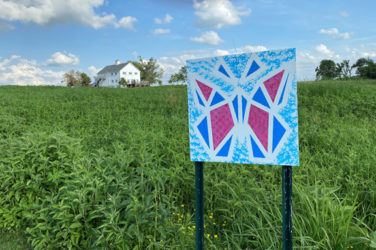 Primary reportage by Tim Bascom
Primary reportage by Tim Bascom
University of Iowa Museum of Art
Sande Mask
The University of Iowa Museum of Art in Iowa City encompasses one of the best collections of any university museum in the United States. Its valuable holdings include large masterpieces by expressionist painters Jackson Pollock and Max Beckmann. Because a flood destroyed the museum in 2008, a number of its American and European works are temporarily on view at the Figge Art Museum in Davenport. Plenty of entrancing art remains on campus, however, in scattered gallery spaces.
If you exit Interstate 80 and head for the Iowa Memorial Union, you’ll encounter a terrific group of African pieces: masks, fetishes and embroidered textiles. Give your complete attention to the Sierra Leone Sande mask (page 81), which was carved and reserved for Gola women performing an initiation rite for adolescent girls.
Traditionally these girls are escorted away from their villages to be trained in rules of conduct, dance steps, songs, legends and medicinal recipes. Afterward they’re led back by a female dancer who wears, above a black costume covering her from the neck down, the sort of mask that’s on exhibit. You’ll note this mask is sleek and dark, suggesting the oiled, healthy skin of a beautiful woman in her prime. It also bears another classic signifier of feminine status and allure—a highly elaborate hairstyle. This unforgettable piece epitomizes the ideal Gola woman, who educates girls and then points them toward their futures.
 Figge Art Museum
Figge Art Museum
The Marriage of the Virgin
Opened in 2005 and still the newest cultural icon in Iowa, Davenport’s Figge Art Museum rises authoritatively alongside the Mississippi River. The building, designed by renowned British architect David Chipperfield, is composed of giant blocks sheathed with glass that reflects the changing sky. The Figge’s worth a trip just to admire its structure.
Even jaded art tourists call the collection here remarkable, especially when it comes to 19th-century American landscapes. Please don’t, however, miss “The Marriage of the Virgin” in the Vice Regent Collection. It’s an eccentric masterpiece, completed when Spain ruled Mexico.
A little background helps explain this painting’s hallucinatory nature. During the 16th century, rebellious Protestants hurled charges that the Catholics’ favorite art—Bible-based, yet sumptuous and sophisticated—betrayed damning strains of worldliness and idolatry. Catholics, in a defensive response, announced at the Council of Trent that religious painting would henceforth conform to far stricter rules of decorum. Artists were ordered to represent what a Figge curator describes as “the essence that inspired the image, rather than the image itself.”
Putting it plainly, that era’s Church-commissioned painters, no matter how fanciful and luxurious their visions, needed to evoke on every canvas a dominant presence of the great, unseen Almighty—a presence that would manage to strike viewers much more viscerally than any other tried-and-true, sensuously tangible and lovingly brushed compositional element. (Think massive, gorgeously satin-hung beds that upstaged the pallid saints expiring beneath their canopies.)
In “The Marriage of the Virgin,” we witness colonial Mexican artist Luiz Juarez, fully conscious of the Council of Trent’s edict, laboring faithfully to convey a pre-eminent, divine essence. His solution to that stress-inducing problem is a pair of disembodied hands that emerge from puffy clouds to (somewhat forcibly) pull Mary toward Joseph, her groom. A bishop planted between this primal male and female embodies the authority of the Spanish Church, and also strengthens the pious atmosphere. (As a side note, this piece is so rigidly symmetrical that you could split it to produce halves with identical columns and cherubs.) Rule-bound, definitely. But this painting’s manifest inhibitions make it fascinating.
 Brunnier Art Museum
Brunnier Art Museum
Lake Como Vase
What separates the Brunnier Art Museum at Iowa State University in Ames from other museums across the state is its emphasis on decorative arts. While visiting, you may well spend more time than you’d allotted to study the splendid objects on view. Your best method of approaching the Brunnier’s treasures is to come in really close. That way, you can savor the smallest details on, say, a Wedgwood game pie dish, a piece so like an ornate wedding cake that you could practically cut a slice and eat it.
Pictured here for its marvelous craftsmanship is an early 20th-century art nouveau vase. It presents a view of Lake Como, the eternally stylish Italian resort. This vase epitomizes the cameo technique; it was created by ever so carefully blowing a basic shape from several thin, molten layers of colored glass. Once it cooled and hardened, a workshop of artisans assembled by French artist Emile Galle protected some surface areas with a coat of wax. Then they etched other areas with acid, bringing the landscape up from different-hued depths. Voilá! A cobalt-blue exterior reveals the graceful composition of dark trees, a light-blue lake and a white-capped mountain under lemony skies.
 Sioux City Art Center
Sioux City Art Center
Burning Tree with Ryder Sky
Crisp brick wings define the Sioux City Art Center. Though they jut into the manicured grounds at seemingly random angles, they’re securely anchored by a wide central cylinder clad in glass. The building, just a short walk from the Missouri River, is particularly camera-ready after sunset, when its glazed core lights up from within like an enormous Japanese lantern.
This museum commits itself totally to works by Midwesterners. Naturally the Undeniable Triumvirate is present and accounted for—Grant Wood, Thomas Hart Benton and John Steuart Curry. But it’s a treat to discover intriguing works by that mighty trio’s peers, like Gladys Lux or Francis Robert “Bob” White, the first director of the Sioux City Art Center. (White succeeded Wood as manager for all Works Progress Administration art projects in Iowa.)
Refreshing, too, is the fact that Sioux City constantly and enthusiastically buys the work of talented, contemporary creatives. The arresting photograph on the opposite page is by Kansas native Larry Schwarm,
who makes images of controlled burns as they move across the tall-grass prairie near Emporia. Schwarm’s picture records a flaming tree at night, when it has taken on a mysterious, near-abstract quality. Both the photo and its title pay respects to a 19th-century tonalist, Albert Pinkham Ryder, who painted eerie midnight scenes.
Using a lengthy exposure to consolidate light from the moon and the almost-burnt tree, Schwarm renders the remnant flames as a kind of startling lightning stroke. The photograph’s accompanying caption explains that light, in this nocturnal setting, “becomes a physically tangible material,” and gives the image “an unreal character where distance and form dissolve into one another.”
As do many worthwhile artworks, Schwarm’s photograph shakes us up. It alters our perceptions, leaves its mark in our minds. Not surprisingly, intrigued Art Center sponsors and other Sioux City citizens voted to add this print to their ever-growing Legacy Collection.
![31_1_Wood_WomanWithPlants_1_lgjpg[2]](http://www.ia-magazine.com/wp-content/uploads/2012/09/31_1_Wood_WomanWithPlants_1_lgjpg2.jpg) Cedar Rapids Museum of Art
Cedar Rapids Museum of Art
Woman with Plants
Grant Wood—the game-changing artist who looked at small Iowa farms and saw seminal, voluptuous landscapes—spent most of his childhood in Cedar Rapids. He’s celebrated as a native son, and the Cedar Rapids Museum of Art boasts the largest collection of his art anywhere.
The portrait shown here, “Woman with Plants,” was painted just as Wood was establishing his distinctive, mature style—boldly frontal and precise. The subject is his mother, Hattie Weaver Wood. Her son’s brush defines her as an exemplary pioneer: weathered, firm, reserved. You can’t miss the upstanding, potted sansevieria she carries; it’s symbolic of her feminine strength. Note, too, the portrait’s repetition of colors, as pointed out in the museum’s description. Hattie’s eyes are the same blue as the sky; her hands match the sheaves of corn; her gray-green apron echoes her striped plant. This painting is a private tribute to a matriarch, offered by the devoted child who practically never left her side. But it’s also a very universal image, which is why it mesmerizes art lovers from around the globe.
While you’re visiting the Cedar Rapids Museum of Art, take in its unexpected array of Roman busts, one of the museum’s hallmark collections. The building itself, originally a dignified, circa-1905 Carnegie Library, was boisterously remodeled and enlarged in the late 1980s by that guru of postmodern architecture, Charles Moore. Now, Moore’s own once-radical notions have been filed under “history.”
 Faulconer Gallery
Faulconer Gallery
Disasters of Peace #12, Mind the Gap
Grinnell College’s Faulconer Gallery may not be large, but with its emphasis on social commentary it packs a wallop. The Faulconer displays works from a deep, permanent collection of 5,000 pieces, including prints by artists who’ve expressed their personal opinions vividly and publicly.
William Hogarth, a leading example, revealed the soul-killing effects of poverty and imprisonment in 18th-century England. Kathe Kollwitz’s images protested the steamrolling nationalism that flattened 20th-century Germany. The Faulconer continues to acquire challenging, politically conscious works. An etching reproduced for this story is by Diane Victor, a South African who has watched apartheid arrive and depart. It’s taken from Victor’s series of etchings titled “Disasters of Peace;” these form a contemporary homage to the masterly 19th-century Spanish painter and provocateur, Francisco Goya. (Among other reasons for reverence, Goya issued his own wrenching series of etchings, “The Disasters of War.”)
In Victor’s work, a homeless South African black woman is shown pushing all her possessions, including a child, in a shopping cart. Surreally, she trundles past panels of the kinds of pictures and tantalizing descriptions typically encountered in residential real estate brochures. The houses Victor depicts are presumably Cape Town mansions, made fortress-like by fences or high walls. One snippet of advertising copy reads: “A steal … 24-hour security.” Up in the sky behind Victor’s subject, a jet rises and flies away. But she stays trapped in a modern-day hell.
![Sargent,-John-Singer[2]-2](http://www.ia-magazine.com/wp-content/uploads/2012/09/Sargent-John-Singer2-2.jpg) Des Moines Art Center
Des Moines Art Center
Portraits of Edouard and Marie-Louise Pailleron
If you want to claim you’ve skimmed the cream off art in Iowa, a day at the Des Moines Art Center becomes imperative. The building uniquely joins three designs from canonical architects. A highly finessed horizontal stone building (by Eliel Saarinen, 1948) connects to a hammered-concrete extension (I.M. Pei, 1968) and also to a gleaming white enameled-steel tower (Richard Meier, 1985).
The Art Center’s holdings are studded with masterpieces endlessly reproduced in encyclopedias and college textbooks. Take, for example, Edward Hopper’s painting, “Automat,” with its solitary woman drinking coffee at
night. Or Francis Bacon’s gold-framed rendition of a horrifically screaming Pope Innocent X. In addition to prized paintings, there’s great sculpture here, too, from major figures like Constantin Brancusi and Louise Bourgeois.
To pick one piece that represents the Art Center is to neglect dazzling options. But here’s a perennial favorite: John Singer Sargent’s portrait of two haughty, privileged French children, from 1881. This painting is a tour de force. Its dashing, expressive brushwork is hard to believe—look at the boy’s curving fingers and his sister’s silk dress. But what catapults the piece over the top is Sargent’s witty, startlingly frank depiction of the young sitters’ boredom and anger.
No one could fail to empathize with the siblings’ frustration. Accustomed to doing what they pleased, they were required by their perfectionist painter to dress in their best clothes and stay very still through 83 separate posing sessions. A less daring 19th-century portraitist would have provided Edouard and Marie-Louise with synthetic, sugary smiles. But Sargent’s confidence bolstered him as he faced off with the glum, restless duo. He had the courage to show them as they were—which lets today’s viewers peg them as real little commandants, a type we know well.
It’s easy to imagine that Sigmund Freud, born the same year as Sargent, would have been amused to analyze the children’s broiling, barely repressed emotions. Supposedly, as soon as Sargent finished his painting, 9-year-old Marie-Louise was allowed to throw her silk dress out the window. Set free from his resentful subjects, Sargent himself danced a jig.
 Blanden Memorial Art Museum
Blanden Memorial Art Museum
Des Moines River, North of Fort Dodge
The Blanden Memorial Art Museum in Fort Dodge occupies a handsome pavilion essayed in the Italian Renaissance style by local architect E.O. Damon Jr. and opened in 1932. Its corners are emphasized with generously scaled pilasters; its entry is protected by a tall, three-arched loggia. Inside you’ll spy a worthy cluster of colorful pieces by first-generation abstractionists like Russia’s Wassily Kandinsky. The Blandon contains other, similarly graphic, tactile artworks—a hint that this place advocates hands-on experiential learning, with employees trained to guide distraction-prone children. (Perhaps these patient staffers could even have snared the thoughts of Edouard and Marie-Louise Pailleron.)
Though Robert Alden Reaser did his huge pastel—six feet wide—in 1924, it brings to mind the earlier paintings of French artist Claude Monet, or of Georges Seurat, who combined tiny dots for a radiant overall effect. Maybe Reaser viewed their works while he was stationed in France as an ambulance driver during World War I. Of his affection for Iowa we’re certain: Both parents grew up in Fort Dodge, and Reaser frequently returned there. His pastel commemorates the bending Des Moines River, shown before its banks were graded down by developers. Today Reaser’s peaceful vista is occupied by a housing subdivision and the Fort Dodge airport.
Tim Bascom writes often about the arts, including pieces that have appeared in dsm, the University of Iowa alumni magazine, and the in-flight magazines of China Airlines and Ethiopian Airlines. His essays have been selected for anthologies such as “Best American Travel Writing” and “Best Creative Nonfiction.” When not writing he loves to tour art museums, including, most recently, the San Juan Museum of Art and History in Puerto Rico.
Current and upcoming exhibits at selected Iowa art museums
Blanden Memorial Art Museum, Fort Dodge
Seeing the World
Through Dec. 29, 2012. Etchings, lithographs and aquatints by American and European artists selected from the museum’s permanent collection.
Brunnier Art Museum, Ames
Cabinet of Curiosity
Through Dec. 14, 2012. Mimicking the intriguing style of old cabinet museums, where everything from treasured statues to animal parts was stored for passers-by to view. This exhibit gives the idea a new, more educational twist by incorporating scientific equipment.
Post-Pop Redux
Through Dec. 14, 2012. A collection of found-material sculptural art by
St. Louis artist Andy Magee.
Cedar Rapids Museum of Art, Cedar Rapids
Charles Barth: A Kaleidoscope of Culture
Through Jan. 5, 2013. Vibrant paintings and prints of Mexican culture by artist
Charles Barth, who splits his time between Cedar Rapids and Oaxaca, Mexico.
Marvin Cone: An American Master
Through Jan. 20, 2013. Seven-gallery exhibition of paintings and drawings by Marvin Cone (1891-1965), an American painter in the regionalist style. A friend of Grant Wood, Cone lived in Cedar Rapids for most of his life.
Des Moines Art Center
Iowa Artists 2012: Print
Oct. 5, 2012–Jan. 13, 2013. Print-based media, such as screen printing, stencil, relief, intaglio and more by artists living and working in Iowa.
Thomas Demand: Animations
Nov. 2–Dec. 16, 2012. Featuring internationally renowned German artist Thomas Demand. The artist constructs large maquettes of real architectural spaces where important historical events have occurred or places that have become familiar to the public through the mass media.
Transparencies: Contemporary Art and A History of Glass
Feb. 21–May 26, 2013. Featuring works of glass, from chandeliers to windows, by a group of international contemporary artists including Monir Farmanfarmaian, Judith Schaecter and Rachel Whiteread.
Faulconer Gallery, Grinnell
Robert Polidori
Jan. 25–March 17, 2013. Large-scale color photographs of desperate, fascinating and unseen places, including the aftermath of Hurricane Katrina and the 2010 earthquake
in Haiti.
Lorna Bieber
May 17–Sept 8, 2013. Multi-panel drawings of the world by New York artist Lorna Bieber.
Figge Art Museum, Davenport
Rose Frantzen—Portrait of Maquoketa
Oct. 27, 2012–Jan. 20, 2013. Series of panels with painted portraits of 180 Maquoketa residents. In 2005, artist and Maquoketa native Rose Frantzen transformed an empty storefront on the town’s main street into a studio and extended an open invitation to residents to sit for an impromptu portrait session.
Picturing Identity—The Allure of Portraiture
Nov. 17, 2012–Feb. 17, 2013. Portraits produced during the 19th and 20th centuries of celebrities, presidents and other public figures.
American Pop
May 4–Sept. 1, 2013. Works by pop artists, including James Rosenquist, Jim Dine, Roy Lichtenstein, Ed Ruscha, Robert Indiana and Andy Warhol. Frequently adopting commercial methods of printmaking like silkscreen and lithography, pop artists downplayed the idea of artistic “originality” by equating art to consumer products or marketing materials.
Sioux City Art Center
City Art Quilts
Oct. 25–Dec. 2, 2012. Works from the Art Center’s most recent community project, which involved regional artists making drawings that then were used to create 17 art quilts.
Larry Roots: On the Surface
Nov. 3, 2012–Feb. 3, 2013. Abstract paintings and mixed-media works from Nebraska artist Larry Roots.
The University of Iowa Museum of Art, Iowa City
Napoleon and the Art of Propaganda
Through Jan. 26, 2013. More than 120 drawings, paintings, prints, sculpture, medals and manuscripts that belonged to Napoleon Bonaparte and his Imperial Court. The art and artifacts are from the renowned private collection of Frenchman Pierre-Jean Chalencon.





